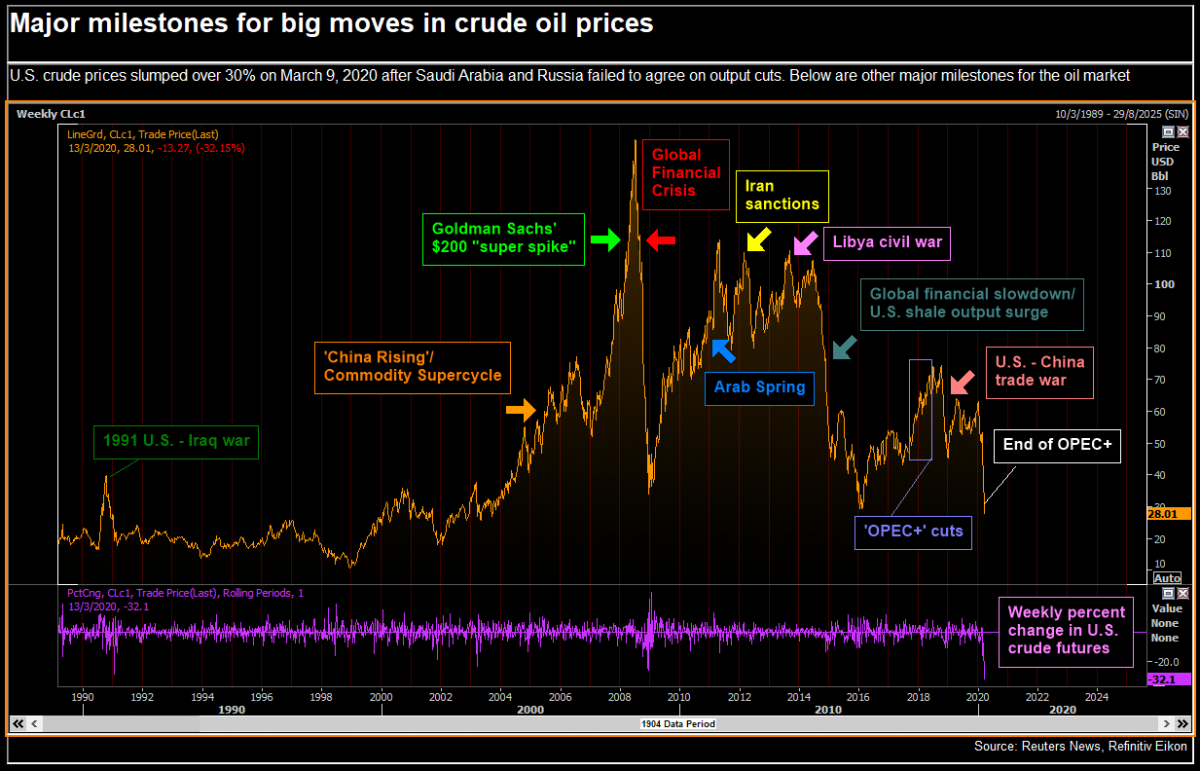NEW YORK, (Reuters) – Oil prices suffered their biggest daily rout since the 1991 Gulf War today as top producers Saudi Arabia and Russia began a price war that threatens to overwhelm global oil markets with supply.
A 20% slump in oil prices triggered another day of heavy losses on Wall Street’s main stock indexes as the rapid spread of coronavirus amplified fears of a global recession.
Saudi Arabia and Russia both said they would raise production at the weekend after a three-year pact between them and other major oil producers to limit supply fell apart on Friday. Moscow had refused to support OPEC in making a deeper oil cut to cope with the substantial fall in demand caused by the impact of coronavirus on travel and economic activity.
Brent crude futures were down $9.15, or 20.2%, to $36.12 a barrel by 1:06 p.m. EDT (1706 GMT). They earlier fell by as much as 31% to $31.02, their lowest since Feb. 12, 2016.
U.S. West Texas Intermediate (WTI) crude fell $8.16, or 19.8%, to $33.12 a barrel. WTI earlier dropped 33% to $27.34, also the lowest since Feb. 12, 2016.
If losses hold, Monday would be the biggest one-day percentage decline for both benchmarks since Jan. 17, 1991, when oil prices fell a third at the outset of the U.S. Gulf War.
Energy stock prices have also fallen sharply, and shale producers began cutting spending in anticipation of lower revenues. Shares for Exxon Mobil Corp and Chevron Corp fell by 9% and nearly 14% respectively.
Saudi Arabia plans to boost its crude output above 10 million barrels per day (bpd) in April after the current deal to curb production expires at the end of March, two sources told Reuters on Sunday. Saudi Arabia also cut its official crude selling price.
The kingdom has been producing around 9.7 million bpd in recent months.
Russia, one of the world’s top producers alongside Saudi Arabia and the United States, also said it could lift output and that it could cope with low oil prices for six to 10 years.
OPEC, Russia and other producers had cooperated for three years to restrain supply in a group known as OPEC+. Other countries in that group are likely to raise supply and cut prices to compete, adding supply to a market already awash with crude.
“The prognosis for the oil market is even more dire than in November 2014, when such a price war last started, as it comes to a head with the significant collapse in oil demand due to the coronavirus,” Goldman Sachs said.
Saudi Arabia, Russia and other major producers last battled for market share in 2014 in a bid to put a squeeze on production from the United States, which has not joined any output limiting pacts and which is now the world’s biggest producer of crude thanks to a rapid rise in output from the shale sector.
The global outbreak of the coronavirus prompted OPEC to seek additional output cuts. More than 110,000 people have been infected in 105 countries and territories and 3,800 have died, the vast majority in mainland China, according to a Reuters tally.
China’s efforts to curb the coronavirus outbreak has disrupted the world’s second-largest economy and cut shipments to the biggest oil importer.
The International Energy Agency said on Monday oil demand was set to contract in 2020 for the first time since 2009. The agency cut its annual forecast and said that demand would contract by 90,000 bpd in 2020 from 2019.
Major banks also have cut their demand growth forecasts. Morgan Stanley predicted China would have zero demand growth in 2020, while Goldman Sachs sees a contraction of 150,000 bpd in global demand.
Bank of America reduced its Brent crude price forecast to $45 a barrel in 2020 from $54 a barrel.
“The radical shift in policy suggests that Saudi will allow inventories to build sharply over the next three quarters,” said a Bank of America Global Research report. “As a result, we now expect Brent oil prices to temporarily dip into the $20s range over the coming weeks.”

